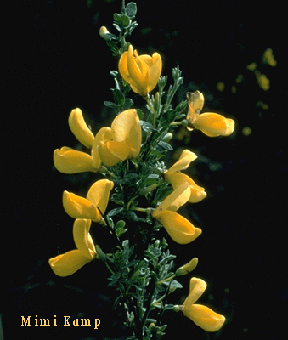
Cytisus scoparius
Common Names: Scotch Broom, Broom, Hogweed
Clinical Names: Cytisus scoparius, Sarothamnus scoparius.
Summary
botanical names: Cytisus scoparius, Sarothamnus scoparius.
common names: Scotch Broom.
overview of interactions:
• herb affecting drug class toxicity: Monoamine Oxidase Inhibitors
• herb affecting drug performance: Digoxin
AHPA Botanical Safety Rating: 3
Clinical
botanical names: Cytisus scoparius, Sarothamnus scoparius
common names: Scotch Broom, Broom, Hogweed.
part used: Flowering tops.
action: Cardioactive diuretic, peripheral vasoconstrictor.
dosage:
• dried: 1 - 2g ., three times per day.
• tincture: 1:5; 0.5 - 2.0 ml., three times per day.
therapy: Tachycardia, edema of cardiac origin, functional palpitations with lowered blood pressure.
(The British Herbal Pharmacopoeia, 192.)
AHPA Botanical Safety Rating: 3
toxicity:
• Considered an unsafe herb by the FDA.
• Toxicity symptoms parallel those of nicotine poisoning: circulatory collapse, tachycardia, ileus, nausea, diarrhea, vertigo, headache. In animals, lethal doses cause death by cardiac arrest.
(Duke JA.1985, 155)
contraindications:
• Pregnancy: Sparteine is oxytocic and abortifacient.
(Duke JA.1985, 155; Brinker F. 1988, 120.)
• Hypertension: Due to vasoconstrictive action increasing
afterload.
pharmacology: Sparteine depresses myocardial excitability.
indications: Edema of cardiac origin, profuse menstruation.
constituents:
• Alkaloids: Quinolizidine variety, including cytisine, sparteine.
• Flavonoids: including quercitin, isoquercitin.
• Isoflavones: including genistein, scoparin.
• Volatile oils: including eugenol.
• Miscellaneous: Bitters, tannins, organic acids.
Interactions
herb possibly affecting drug class toxicity: Monoamine Oxidase Inhibitors
• mechanism: Cytisus contains <2% tyramine, concentrated in the flowers. Tyramine is a nutrient which is catabolized by gut and hepatic MAO. Tyramine foods are contraindicated with MAOI drugs due to the possibility of massive and precipitous epinephrine release as tyramine enters systemic circulation acting as a "false-transmitter" if gastro-intestinal MAO is inhibited. This interaction can result in serious hypertensive crisis and has been well documented for tyramine-containing foods. Reports of
Cytisus interactions with MAOI drugs are not available.
(Hardman J, et al. 1996, 204-205)
• herbal concern: The relatively small quantities of tyramine in
Cytisus relative to the therapeutic dose of 0.5-.2.0 mls (1: 5) tincture, means the tyramine content per dose would be between 2.0 mg.- 8.0 mg. In physiological terms the bradycardic and hypertensive actions of sparteine in
Cytisus are more likely to interact with MAOI drugs than the tyramine content. Nonetheless, patients using MAOI drugs should be cautious with the use of
Cytisus preparations.
herb affecting drug performance: Digoxin
• herbal concern: Due to the effects of sparteine and related alkaloids from
Cytisus on myocardial conduction, Cytisus should not be used concurrently with drugs affecting conduction, such as Digoxin.
Cytisus may be combined with cardiac glycoside herbs of moderate toxicity such as
Convallaria, in the treatment of cardiac edema.
(BHP, 1983, 192.)


Please read the disclaimer concerning the intent
and limitations of the information provided here.
Do not rely solely on the information in this article.
The information presented in Interactions is for
informational and educational purposes only. It is based on scientific
studies (human, animal, or in vitro), clinical experience, case
reports, and/or traditional usage with sources as cited in each
topic. The results reported may not necessarily occur in all
individuals and different individuals with the same medical conditions
with the same symptoms will often require differing treatments. For
many of the conditions discussed, treatment with conventional medical
therapies, including prescription drugs or over-the-counter
medications, is also available. Consult your physician, an
appropriately trained healthcare practitioner, and/or pharmacist for
any health concern or medical problem before using any herbal products
or nutritional supplements or before making any changes in prescribed
medications and/or before attempting to independently treat a medical
condition using supplements, herbs, remedies, or other forms of
self-care.
References
Bradley PR, ed. British Herbal Compendium, vol 1. Bournemouth, Dorset, UK: British Herbal Medicine Association, 1992.
Brinker F. Herb Contraindications and Drug Interactions. Second edition., Sandy, OR: Eclectic Institute Inc, 1998.
Brinker F. The Toxicology of Botanical Medicines, rev. 2nd ed., Sandy, Oregon: Eclectic Medical Publications, 1996.
The British Herbal Pharmacopoeia, Bournemouth K, BHMA, 1983, 192.
De Smet PAGM et al. (eds.) Adverse Effects of Herbal Drugs 2, Berlin: Springer-Verlag, 1993.
Duke JA. CRC Handbook of Medicinal Herbs Boca Raton, Fl. CRC Press, 1985.
Farnsworth NR, Bingel AS, Cordell GA, Crane FA, Fong HHS. 1975. Potential Value of Plants as Sources of New Antifertility Agents I.
J Pharm Sci. 64:535-598.
Felter HW, Lloyd, JU. King's American Dispensatory, Vols. I and II. Portland, OR: Eclectic Medical Publications, 1983.
Hardman J, et al. (eds.) Goodman & Gilman's Pharmacological Basis of Therapeutics.
Ninth Edition. McGraw Hill, 1996.
McGuffin M, et al. (eds.) AHPA Botanical Safety Handbook . CRC Press, 1997.
Thienes CH, Haley TJ. Clinical Toxicology. 5th ed. Philadelphia: Lea and Febiger, 1975.



![]()